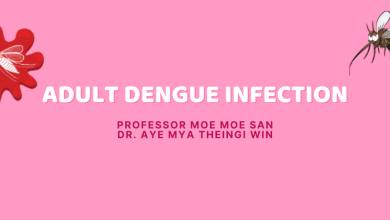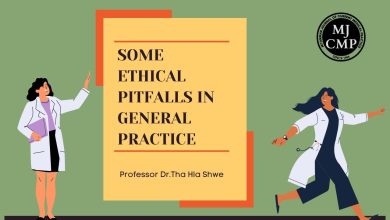Low back pain is among the most common clinical problems.
Low Back Pain Presentation
1. Lumbago (or) low back pain
Lumbago means pain in the lower back only. The pain would originate from the structures related to muscle, ligament mainly but not to nerve nor facets.
2. Low back pain with sciatica
Means pain in the lower back and/or buttock traveling along the posterior part of thigh, leg to dorsum of foot. Example: Herniated disc L4-5 compresses on nerve root L5
3. Low back pain with femoral pain
Means pain along course of femoral nerve, that is anterior thigh pain. Example: Forward slip of L3 vertebrae on L4 causes tension on root L4
4. Low back pain with referred pain
Means besides the pain in the lower back, the original pathological structure may also cause referred pain lower down to buttock or higher to upper back. Referred pain has no specific sensational dermatome.
Etiologic Factors in Low Back Pain
I. Congenital disorders
A. Facet Tropism (Asymmetry)
B. Transitional Vertebra
a. Sacralization of Lumbar Vertebra
b. Lumbarization of Sacral Vertebra
II. Trauma
A. Lumbar strain
1. Acute
2. Chronic
B. Compression Fracture
1.Fracture of Vertebral Body
2. Fracture of transverse Process
C. Subluxated Facet Joints (Facet Syndrome)
D. Spondylolysis and Spondylolisthesis

Spondylolysis and Spondylolisthesis

Posterior oblique view showing radiographic Scotty dog. In simple spondylolysis, dog appears to be wearing a collar.

In spondylolisthesis, Scotty dog appears decapitated.
III.Mechanical
- Intrinsic (eg. poor muscular tone, chronic postural strain, unstable vertebrae)
Intrinsic (Postural and Muscular)


2. Extrinsic (eg. uterine fibroids, pelvic tumors or infections, hip diseases, prostate disease, untreated lumbar scoliosis)

3. Prolapse Inter-vertebral Disc
Mechanical Cause of Prolapsed Intervertebral Disc
- Mechanical low back pain is acute in onset frequently associated with a definite history of lifting (or) bending.
- Radiation of pain with nerve root irritation. Pain is aggravated by coughing, sneezing and straining
- Compression of motor fibers of the root results in atrophy and weakness in the muscles innervated by the affected nerve. Severe sciatic pain radiation along the course of the sciatic nerve.
Relationship of Spinal Nerves to Vertebrae Lateral Disc Protrusion at Level 4-5

Lateral disc protrusion at Level 4-5 affects 5th, not 4th lumbar nerve; similarly, protrusion at L5- S1 affects 1st sacral, not 5th lumbar nerve
Relationship of Spinal Nerves to Vertebrae Mid-Line Protrusion at Level 4-5

Midline protrusion at Level 4-5 may affect 5th lumbar and 1st, 2nd, 3rd or more sacral nerves but not 4th lumbar nerve
Clinical Features of Herniated Lumbar Nucleus Pulposus L3 – 4

Clinical Features of Herniated Lumbar Nucleus Pulposus L3 – 4

Clinical Features of Herniated Lumbar Nucleus Pulposus L4 – 5

Clinical Features of Herniated Lumbar Nucleus Pulposus L4 – 5

Clinical Features of Herniated Lumbar Nucleus Pulposus L5 – S1

Clinical Features of Herniated Lumbar Nucleus Pulposus L5 – S1

Clinical Features of Herniated Lumbar Nucleus Pulposus (Massive Midline Protrusion)

Clinical Features of Herniated Lumbar Nucleus Pulposus (Massive Midline Protrusion)

IV. Degenerative Disorders
1. Lumbar Spondylosis
2. Osteoarthritis
3. Spinal Stenosis – nerve root entrapment syndrome
Lumbar Spondylosis
- characterized by degeneration in the intervertebral disc.
- Spondylosis is asymptomatic.
- Symptoms are precipitated only when fatigue or injury upsets the normal homeostatic status of the spine.
Osteoarthritis
- is “wear-and-tear” phenomenon and is associated with the degenerative changes in the articular cartilages.

Spinal Stenosis
- Degenerative diseases such as spondylosis in the disc (or) osteoarthritis in the fact joints of the lumbar vertebrae can also cause spinal stenosis.
V. Infection of Lumbar Vertebra
A. Acute pyogenic infection
- In young patients – from the respiratory tract
- In old patients – the genitourinary tract
- At all age, post operative wound infections
B. Chronic infections
- Brucella (or) Mycobacterium organisms
- Spinal column tuberculosis
VI. Inflammatory Diseases of the Spine
• Ankylosing Spondylitis usually occurs in young men (<40 years), primarily affects the
vertebral column and sacro-iliac joints.
• Earliest complaint is usually low back pain with marked limitation of spinal movements in all directions.
Marie-Strumpell (Ankylosing Spondylitis)

VII. Metabolic Disorders
• Osteoporosis
• Osteomalacia
• Paget’s disease
• Hyperparathyroidism
VIII. Tumors
A. Benign
- Tumors involving nerve roots or meninges (e.g.neurinoma, hemangioma, meningioma)
- Tumors involving vertebrae (e.g. osteoid osteoma, Paget’s disease, osteoblastoma)
B. Malignant
- Primary bone tumors (e.g. multiple myeloma)
- Primary neural tumors
- Secondary tumors (e.g. metastasis from breast, prostate, kidney, lung, thyroid)
Vertebral Column Tumors – Malignant
Primary

Secondary (Metastatic)

IX. Referred pain
- Peptic ulcer
- Pancreas
- Bowel
- Kidney
- Abdominal aortic aneurysm
- Endometriosis
- Retroperitoneal fibrosis
- Hip disease
- Polymyalgia Rheumatica
- Herpes Zoster
X. Others
- Fibromyalgia
- Diffuse idiopathicskeletalhyperostosis(DISH)
- Scheuermann’s osteochondritis
- Heavy metal poisoning (e.g. Radium)
- Psychoneurotic problems (e.g. hysteria, malingering)
Clinical Evaluation
Medical History
( a ) Age
( b ) Occupation
( c ) Onset of pain
( d ) Pain characteristics
( e ) Temporal and mechanical feature
Segmental Sensory Innervation (Dermatomes) of Lower Limb

Examination of Patient with Low Back Pain
A. Standing


B. Kneeling on chair

C. Seated on table

D. Supine

E. Prone

Segmental Innervation of Lower Limb Movements

F. Rectal and/or Pelvic Examination
G. X-rays of Thoracic and Lumbar Spine
Anteroposterior, lateral, right and left oblique views. Pelvic and spot films as indicated.
H. Laboratory
Serum Ca and P, alkaline phosphatase, acid phosphatase (male over), CBC, ESR and urinalysis.
Principles of Treatment
A. Conservative Treatment
B. Surgical Treatment
A. Conservative Treatment
- General measures – Education
- Short period of bed rest (3-7 days) during acute pain phase followed by an active exercise program.
- Drugs
- Simple analgesics and sedatives
- NSAID
- Tricyclic antidepressants
1. Physiotherapy
- Electrical therapy
- Active exercise program
( i )Flexion exercise for spondylolisthesis and spinal stenosis
( ii )Extension exercise for ankylosing spondylitis
( iii ) Isometric exercise for chronic low back pain (post operative)
- Abdominal strengthening and low back flexibility exercise for postural back pain
- Manipulation
- Lumbar traction
Treatment of Lumbar Strain
Acute
- Absolute bed rest
- Warm tub baths, heat pad, hydrocollator
- Sedation
- Firm mattress, bed board
- Diathermy, massage
- Local anesthetic infiltration to trigger zones.
- Occasionally coreset, brace or strapping
Chronic and prophylactic
- Reduction of weight
- Correction of posture
- Firm mattress, bed board
- Daily low back exercises
- Regular sports activity compatible with age and physique
Exercise for chronic lumbar strain
- (Starting positions in outline)
- Exercise are best done on hard, padded surface like carpeted floor. Start slowly. Do each only once or twice per day, then increase progressively to 10 or more times within limits of comfort. Pain, but not mild discomfort, is indication to stop.


1. Lie on back, arms on chest, knees bent. Press small of back firmly down to floor, tightening muscles of abdomen and buttocks, thus tilting pubis forward; exhale simultaneously. Hold for count of 10, relax and repeat.

2. Lie on back, arms at sides, knees bent. Draw knees up and pull them firmly to chest with clasped hands several times. Relax and repeat. Also, repeat exercise using one leg at a time.

3. Lie on back, knees bent, arms folded on chest or at sides. Sit up using abdominal muscles and reach forward. Return slowly to starting position.

4. Begin in a runner’s starting position (one leg extended, the other forward as shown, hands on floor). Press downward and forward several times, flexing front knee and bringing abdomen to thigh. Repeat with legs reversed.

5. Stand with hands on back of chair. Squat, straightening hollow of back. Return to starting position and repeat.

6. Sit on chair, hands folded in lap. Bend forward, bringing chin between knees. Return slowly to starting position while tensing abdominal muscles. Relax and repeat.
TENS

Infrread

Lumbar Traction

Indications for Lumbar Traction
- Nuclear protrusion (soft disc)
- When manipulation failed
- Lumbar radiculopathy
Contraindications for Lumbar Traction
- Acute lumbago
- Certain cases of sciatica i.e. patients with neurological signs
- Disc protrusion in older age, >60 years where nucleus pulposus cease to exist
- Spinal tumors
- Pregnant women
- Infectious process of spine
Maintenance of Reduction
- By instructing to avoid trunk flexion in all activities of daily living and at work
- By providing lumbar corset for postural correction.
5. Injection
- Injection of local anaesthetic agent into trigger points (facet joints, sacro-iliac joint, myofascial pain areas, etc.)
- Epidural injection with corticosteroid (injection Depo-Medrol 80mg) + (½% 50cc local anesthetic) into epidural space to desensitize the dura and the nerve sleeve.
Epidural Injections are useful for –
Diagnostic purpose
- Uncertain back ache
- Uncertain leg pain
- Contradictory opinion
- Pyschoneurosis
Therapeutic indications in
- Acute Lumbago, acute disc herniation
- Intractable back ache
- Root pain with neurological signs
- Root pain without neurological signs
- Recovering sciatica (SLR improved but pain persists)
- Coccygodynia (Pain present at the coccyx strain at sacrococcygeal joint due to fall on the tail)
Injections are contraindicated in
- Under general anaesthesia
- Local sepsis, previous sepsis
- Previous laminectomy
- Recent myelogran
- Sensitivity
B. Surgical Treatment
- Some of the patients with back pain do not respond to conservation treatment and need to undergo surgery
- Decompressive laminectomy for central, lateral (or) combined spinal stenosis is present at a single level
- Spinal fusion involves welding two or more vertebrae to each other. Effective for patients with severe instability or nerve root entrapment.
Dos and Don’ts

1. Try to stand with your lower back flat. When you work standing up, use a footstool to help relieve swayback. Never lean forward without bending your knees. Ladies take note: shoes with moderate heels strain the back less than those with high heels. Avoid platform shoes.

2. Use a hard chair and put your spine up against it; try and keep one or both knees higher than your hips. A small stool is helpful here. For short rest periods a contour chair offers excellent support.

3. Make sure you lift properly. Bend your knees and use your leg muscles to lift. Avoid sudden movements. Keep the load close to your body and try not to lift anything heavy higher than your waist.

4. Sleep on a firm mattress; put a bed-board (3/4” plywood) under a soft mattress. Do not sleep on your stomach. If you sleep on your back, put a pillow under your knees. If you sleep on your side, keep your legs bent at the knees and at the hips.
For further reading
- Grant’s Atlas of Anatomy 10th Editions, Chapter 4
- PM&R Secrets, Bryan O’Young,MD, Low Back Pain, Page 304
- Medicine International Australia, Far East Edition,No 42, Vol 12, 1998,Neck and Back pain,Page 83
Author Information
Pandora Aung Gyi1and Thet Thet Aung2
1. Senior Consultant Physiatrist
M.B.,B.S(YGN), Dip.Med.Sc, M.Med.Sc., Dr.Med.Sc. (Med. Rehab.), Kumudra Physiocare Centre
2.Senior Consultant Physiatrist
M.B.,B.S(YGN), M.Med.Sc.(Rehabilitation Medicine)






